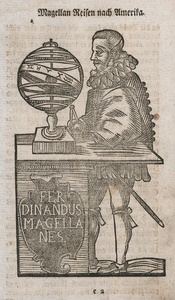| Method | Woodcut |
| Artist | Johann Michael Funcke |
| Published | Nuremberg, 1773. |
| Dimensions | Image 140 x 84 mm, Sheet 193 x 115 mm |
| Notes |
A full length woodcut portrait of the explorer Ferdinand Magellan from the second edition of Georg Adam Dillinger's Bilder-Geographie published in 1773. The portrait shows Magellan standing at a desk, a sphere is seen on the desk, with Magellan holding a pair of dividers as he leans on the side. Ferdinand Magellan (1480-1521) also known as Fernao de Magalhaes in Portuguese or Fernando de Magallanes in Spanish, was born into Portuguese nobility, but his parents died when he was still a boy. He and his brother Diogo got send to the Lisbon court, where Ferdinand lived as a page and developed an interest in cartography, astronomy and navigation. He decided to join the Portuguese navy in 1505 and learned about the competition between the Portuguese and the Spanish to find the quickest sea route to the famous Spice Islands. After serving the navy for several years, he approached King Manuel with a proposal to navigate to the Spice Islands by sailing west from Europe. This was never successfully done before, as the established route was to travel east from Europe to the islands. Not only did Magellan's proposal get rejected, he also didn't receive any further employment from the king after he was wounded in a skirmish in Morocco, and falsely accused of illegal trading with the Moors. In 1517, Magellan decided to approach the Spanish king Charles I, and finally received support to travel east towards the Spice Islands, in hopes of finding a better and shorter sea route to the islands. He set out from Spain with five ships, sailed across the Atlantic, and through the South African Straits, which are now named after him. The journey had been dangerous and troublesome, so that only about half of the crew reached the Philippines in 1521, where they got involved in a battle between two native chieftans, during which Mallegan was killed. The remainder of his crew fled the Philippines under the leadership of Juan Sebastian Elanco (1476-1526), captain of the last remaining ship, and eventually reached the Spice Islands a couple months later. Shortly afterwards they sailed back to Spain, making eighteen men who arrived in 1522, the first to have successfully circumnavigated of the globe. Johann Michael Funcke (1678 - 1749) was a German printer and publisher. Born in Erfurt, the son of an innkeeper, Funcke learned the trade of publisher from his older half-brother Johann Christoph Stössel. When Stössel died in 1709, Funcke took over his business. Funcke went on to publish important works such as Elephantographia Curiosa by Georg Christoph Petri von Hartenfels and Botanica in Originali by Johann Hieronymus Kniphof. Condition: Text to verso. Light printing to centre of image. Spot of foxing to right of figure. Light toning to sheet. |
| Framing | unmounted |
| Price | £150.00 |
| Stock ID | 52578 |

